In Nevada, a tribe and a toad halt a renewable power plant
from WaPO
“The millions of tons of carbon that we don’t put into the air have a positive effect,” Paul Thomsen, the firm’s vice president of business development, said in May as he shielded himself with his pickup’s door from the wind whistling through this sagebrush-speckled valley.
But soon came another legal snag. The company halted construction in August while federal agencies meet to discuss whether the project should move forward. The rugged, remote corner of Nevada’s Great Basin region found itself at the epicenter of a confrontation between some of President Biden’s, and the nation’s, most pressing priorities: renewable energy, wildlife conservation and Indigenous rights.
To tackle climate change, the United States must build new solar farms, wind turbines, transmission lines and other infrastructure at an unprecedented clip. The geothermal power plant could help meet Biden’s ambitious plan to run the U.S. power grid entirely on clean energy by 2035.
But climate change is also fueling an extinction crisis. To protect species from vanishing, as well as to respond to Native Americans’ sovereignty claims, Biden also promised to safeguard nearly a third of the nation’s land and water from development.
The new geothermal plant would tap some of the same underground heat that provides habitat for a rare toad found nowhere else on Earth. And for the first people to populate Nevada, the hot springs represent an ancient and sacred healing place that would be unimaginable to lose.
“We don’t have a church that’s in a building, like a Catholic church or a Mormon church or a Presbyterian church,” said Leanna Hale, land and water resources director for the Fallon Paiute Shoshone Tribe, as she walked down the road near the plant site. Hale’s tribe has sued to stop plant construction and has asked the administration to protect this area from further development. “This is our church.”
Now, Democratic leaders in Congress are trying to advance a bill to accelerate permit approvals for energy projects as part of a broader climate and health-care deal with Joe Manchin III (D). The senator from West Virginia pulled his proposal from a must-pass government operations bill in September in the face of opposition from some Republicans and fellow Democrats.
At the same time, environmentalists and tribes are pressing the Biden administration to begin land and water protections at Dixie Valley and elsewhere.
The administration’s decision could affect not just Ormat’s plans and this patch of Nevada but also projects and landscapes across the country.
Fellow ‘survivors’
To get to Dixie Valley from the nearest city — Fallon, Nev.; population: 9,325 — drive 40 miles east down Highway 50, a ribbon of pavement through desert so isolated that Life magazine once dubbed it the “Loneliest Road in America” since the route has “no points of interest.”
Walking through Dixie Valley as antelope galloped in the distance, Hale questioned that moniker. The Paiute and Shoshone people still come to the hallow and multicolored hills to hunt mule deer, gather pine nuts and heal by washing themselves in the hot springs bubbling up from the valley floor.
“Get out,” Hale said. “Look around. See what’s out here.”
Those same springs sustain the Dixie Valley toad, a black-freckled amphibian found only here. Scientists described it for the first time five years ago.
“Initially, I thought, ‘No way.’ There hadn’t been a new species of toad described in the United States since the Wyoming toad” almost 50 years ago, said Michelle Gordon, a researcher who helped discover the toad in Dixie Valley.
Gordon and colleagues at the University of Nevada at Reno scoured the state for toads, occasionally singeing their skin in the hot springs while searching. Analyzing the amphibians’ genes and physical features, the team identified the toads in Dixie Valley as a separate species from others in the region.
An ancient lake once covered northwestern Nevada, attracting the ancestors of the Paiute and Shoshone to its shores to fish. As the basin dried out, Dixie Valley toads and other animal populations became isolated and evolved on their own, helping make arid Nevada one of the nation’s most species-rich states.
“It’s such unique, cool biodiversity,” Gordon said. “People thought it was just tumbleweeds.”
As a group, toads and other frogs are hardy. They hop on every continent except Antarctica and survived the cosmic collision that killed the dinosaurs.
The tribe’s chairwoman, Catherine Williams-Tuni, called the toad an “ancestor” and fellow survivor. “We feel like us as Native Americans, we’re still survivors.”
Frogs today rank among the most vulnerable to annihilation. About 200 species are thought to have gone extinct since the 1970s. As people warm the planet, spread a fungal disease that ravages their skin and destroy their habitats, a third of amphibians face the risk of extinction.
“Extinction is forever,” said Richard Tracy, a retired herpetologist who co-wrote the 2017 paper on the Dixie Valley toad and wants to make sure his discovery is not added to that list. “Once it happens, then you never, never see that species ever again. It’s gone.”
‘A symbiotic relationship’
This spring, the U.S. Fish and Wildlife Service issued an emergency order protecting the toad under the Endangered Species Act. That rare step put wildlife managers at odds with the Bureau of Land Management, which had trumpeted the Ormat project as part of Biden’s plan to confront the “climate crisis.”
Officials at both agencies are discussing next steps. The Fish and Wildlife Service declined to comment, while BLM said it is “continuing to work with the U.S. Fish and Wildlife Service and Ormat on an appropriate course of action.”
Awaiting a decision, Ormat voluntarily paused construction over the summer. The delay means it cannot meet its contract to supply renewable power to Southern California by the end of the year. Last month, the company asked whether it could move forward with a smaller project and show it can manage the springs.
“At this point, Ormat is considering all options for the sale of the power,” said Thomsen, the company executive.
The Reno-based firm has promised to pump all the water it brings up back underground and to monitor the springs for any changes once the plant is generating. Sustaining the spring, he said, is important for both the toad and the power plant.
“We have to really have a symbiotic relationship with the reservoir,” Thomsen said. “We have to be here operating this facility for the next 20 years to make our contract work. So we are very good stewards of the reservoir, the resource, our neighbors.”
But tribal officials and conservationists worry the water’s chemistry and temperature might be altered too quickly for plant operators or regulators to catch. Even if they did, they argue, it would be hard to muster the political will to shut the plant down.
“Ormat wants to build the plant and do their homework later,” said Scott Lake, an attorney with the Center for Biological Diversity, an environmental group that joined with the Fallon tribe in suing the federal government to stop the plant.
“The thing that really matters to the toad is the temperature of the water,” he added. “It’s what the toad has evolved with over thousands of years.”
The Fallon Paiute Shoshone Tribe wants the Biden administration to protect acreage beyond the toad’s habitat, by turning much of the surrounding area into a national monument or a cultural heritage area.
Flanking Dixie Valley is Fox Peak, a snowy summit central to the tribe’s origin story. Petroglyphs — prehistoric rock writings resembling waves, suns, big-horned sheep and horned lizards — line the mountainsides.
But freshly exposed gray rock on some of the basalt stone offers evidence of recent vandalism. These and other archaeological sites, tribal representatives said, could suffer more damage without increased resources.
This spring, Hale and Williams-Tuni flew to Washington to pitch their plan. The tribal leaders met with representatives from Nevada’s congressional delegation as well as officials at the White House, Interior Department and Navy.
In response, Sen. Catherine Cortez Masto (D) has written an amendment to a must-pass defense bill coming up for a vote soon that would protect nearly 538,000 acres of wildlife habitat while allowing a nearby naval base to expand flight training overhead.
For now, tribal leaders wait for what Washington decides.
Back at the reservation, Hale and Williams-Tuni printed out and penciled in a map of their people’s historic lands. The area they want protected is just a tiny fraction of historic tribal land.
“When you look at the area that we had,” Hale said later, “it’s huge.”
“You think about the mistreatment of the Native people and their lands and their way of life — how destructive. And we are just trying to hang on to what we have.”














